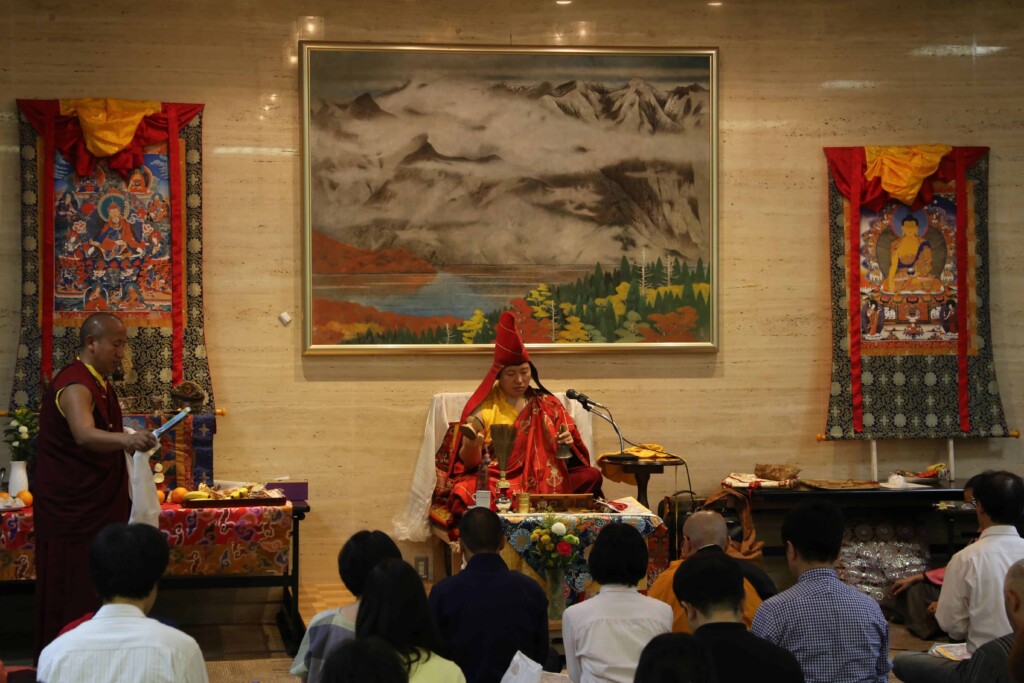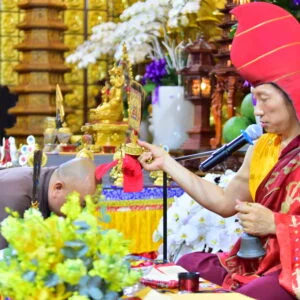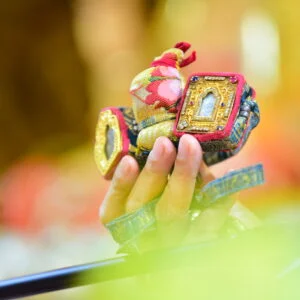Empowerment or initiation has a long history in India and the Himalayan regions. The Sanskrit term abhiṣeka has the connotation of cleansing impurities. The practice is a skillful means that seems to have first emerged as a purification ritual undertaken by practitioners of the tantras. Modern scholars date the emergence of empowerment and the tantric movement from approximately the third century CE in eastern India.1Vajrayāna: Origin and Function. In Buddhism into the Year 2000. International Conference Proceedings, Bangkok and Los Angeles: Dhammakāya Foundation (1995), pp. 89-102 Traditional scholars, however, affirm that the Buddha Shakyamuni taught the tantras secretly. Some Mahayana texts such as the Samādhirājasūtra2The Noble Mahāyāna Sūtra “The King of Samādhis, the Revealed Equality of the Nature of All Phenomena” also allude to the ripening of a disciple through the purifying direct contact with a buddha or realized master.
Gradually, these early ritual practices were expanded beyond purification. This “anointing” process was based upon elaborate coronation rituals of Indian kings or chieftains. As a prince is ritually anointed to become a king, a Vajrayana practitioner is anointed or empowered to practice the esoteric Vajrayana pathway. In the process of empowerment, the buddha-nature that is innately present in the recipient is revealed and activated; the conferring of empowerment does not “give” something to the disciple that was previously not present.
Tsele Natsok Rangdröl, the renowned 17th-century Tibetan master emphasized this point and explained the need for empowerment in this way:
The empowerments are necessary because of the existence of the following four habitual tendencies which obscure the ground, seeds or basic materials:
Tsele Natsok Rangdröl, Empowerment: Wishfulfilling Nectar to Delight the Worthy Offered in Reply to Questions on the Key Points of the Ripening Empowerments and the Mahamudra Path of Liberation, trans. By Erik Pema Kunzang, Rangjung Yeshe Publications, 1997, p. 26.
- the delusion of fixating on the worlds and beings as ordinary and solid.
- the delusion of fixating on speech as ordinary.
- the delusion of fixating on the mind as ordinary, and
- the habitual tendencies of fixating on the three doors as being separate.
Empowerment historically was given to those who were properly prepared and who had already completed mind training under the guidance of a qualified master.
Tsele Natsok Rangdröl answered questions from a disciple about the importance of respecting the secrecy of empowerment. He wrote:
Entering the door to the teachings of Secret Mantra Vajrayana depends upon two things: ripening and liberation. Unless your first obtain the ripening empowerments, you are not authorized to hear even a single verse of the tantras, statements, and instructions. (Unauthorized) people who engage in expanding on and listening to the tantras will not only fail to receive blessings, they will create immense demerit from divulging the secrecy of these teachings. A person who has not obtained empowerment may pretend to practice the liberating instructions, but instead of bringing accomplishment, the practice will create obstacles and countless other defects.
Tsele Natsok Rangdröl, Empowerment, p. 15.
Guru Rinpoche in the Lamrim Yeshe Nyingpo expresses empowerment as the stage of “planting the seeds” in a practitioner.
Since his being abides as the nature of the four vajras
Lamrim Yeshe Nyingpo: The Wisdom Essence of Oral Instructions in the Stages of the Path: The Heart Essence of Padmasambhava According to The Guru’s Heart Practice of Dorje Drakpo Tsal, Powerful Vajra Wrath, Trans. By Erik Pema Kunzang, Rangjung Yeshe Publications.
Of body, speech, mind, and wisdom.
Plant the seeds of the four empowerments
Through the skillful means of the Unexcelled Secret Mantra.
Stages of Empowerment
Empowerment rituals usually employ three stages:
- In the preparatory stage, the vajra master, or guru who is bestowing the empowerment practices “self-empowerment”. Here, the master visualizes himself as the deity. He or she meditates and accumulates the mantra of the particular deity, blesses the surroundings, and eliminates all obstructing or negative forces from the vicinity.
- The disciples who wish to receive the empowerment then are purified with blessed nectar and make an elaborate offering to request the empowerment.
- During the actual empowerment, the vajra master or lama leads the practitioner through the visualization of the particular maṇḍala of deities. He or she then invites the Buddhas to dissolve into them. The vajra master then confers the Vajrayana precepts called samaya or damtshig (དམ་ཚིག་).
Inner Tantras: Four Types of Empowerment
Following the system of the Lamrim Yeshe Nyingpo, there are four ripening empowerments that are given. These usually take place after the disciple has trained his mind through the common and uncommon preliminaries of the outer and inner ngöndro. These are:
- bum wang (བུམ་དབང་) or the “vase empowerment”. During the vase empowerment, the vajra master and practitioners visualize a vase as a celestial mansion populated by enlightened deities. The enlightened deities melt into the liquid in the vase, turning it into a sacred substance. Practitioners then are blessed with this sacred liquid and cleansed of all impurities associated with the negative actions of the body and the nāḍi, or subtle channels in the body. This confers the seed for the practitioner to manifest the tulku (སྤྲུལ་སྐུ་) or emanation body of the Buddha.
- sang wang (གསང་དབང་) or “secret empowerment”. Practitioners are offered drops of amṛta, Tibetan dütsi (བདུད་རྩ) represented by sweetened alcohol from a skull cup. This is said to cleanse the subtle winds (prana) and impurities associated with the negativities of speech. With this empowerment, the practitioner activates the seed to manifest the longku (ལོངས་སྐུ་)—the sambhogakaya or enjoyment body of the Buddha.
- phonya wang (ཕོ་ཉ དབང་) purifies the mind and the tiklé (bindus or essence drops) of the practitioner. Through this empowerment, the mental impurities due to negative thoughts are purified and the practitioner activates the seed to manifest the chöku (ཆོས་སྐུ་), the Dharmakaya or dharma body of the Buddha.
- tshig wang (ཚིག་དབང་) or “word empowerment” is also known as the ultimate empowerment (don wang). The vajra master may use a crystal, a peacock feather, or some symbol to illustrate the nature of the mind. This empowerment purifies the bakchak (བག་ཆགས་) or subtle habitual patterns of body, speech, and mind. Through this empowerment, the practitioner activates the seed to actualize the svabhāvikakāya or ngowo nyi ku, (ངོ་བོ་ཉིད་སྐུ་), the essence body of the Buddha.
Not all levels of empowerment include all four types.
As Guru Rinpoche said in the Lamrim Yeshe Nyingpo:
All these are given to the ordinary person.
Along with preparations, they are initiated and ripened.
Some people of sharp faculties are introduced by means of symbols.
The others, the supreme ones, are liberated merely by samadhi.
An authentic wang or empowerment is a meditative experience and not a passive process. The practitioner follows the instruction of the vajra master in visualizing the deities involved and in arising as that deity. He or she also commits to the tantric samayas. It is said that if one cannot follow the precepts, it’s better not to receive the wang.
Ritual substances are distributed to those attending and often people confuse these blessed substances as empowerment. But genuine reception of the empowerment depends upon the mental state and intention of the practitioner. Once empowered, a practitioner who observes the conduct and follows the instructions of the lama can quickly attain awakening. Receiving empowerment is said to also bring temporary and mundane benefits such as health, happiness, and long life.
Tsele Natsok Rangdröl reminded his disciple of the advantage of receiving empowerment by quoting from the Tantra of the Mind Mirror of Vajrasattva which says:
Having fully obtained all the empowerments,
Tsele Natsok Rangdröl, Empowerment., p. 16.
The entire Secret Mantra is accomplished without hardship.
Receiving Empowerment
Traditionally in Tibetan culture, many people don’t follow the visualization as it is described by the lama or vajra master. This is often the case during larger, public empowerments. In these situations, most people are just there to receive blessed substances. They focus on sipping some holy water or wait to be touched on the head with ritual implements. Then, in common parlance, they say they have “received the empowerment.”
Empowerment or Blessings?
However, in the Vajrayāna tradition, we don’t say that is true empowerment. Instead, we say that the people received some blessings. But in Tibetan culture, many people say that they received empowerment. However, Phakchok Rinpoche notes that he follows his own teacher’s advice. His teacher said that when you don’t follow the visualization explanation given during empowerment, then what you receive is blessings. What do blessings mean?
Blessings
Blessings are quite helpful and important, and we may feel confident that these do exist. When we discuss blessings, we speak of certain benefits. According to Phakchok Rinpoche there are three possible types of blessings:
- We can purify some obstacles and some bad karma
- Our health may improve, or our mind may become a little clearer and our devotion may improve
- Sometimes we may have a wish to achieve something—and through the blessings at an empowerment ceremony you may achieve that wish faster
Tibetan Buddhist Empowerment Has Many Meanings
In Tibetan terminology, we use the word dbang (pronounced wang). That itself is a translation of the Sanskrit abhiṣeka. This term contains several meanings. We can translate it as “pouring” or sprinkling, or cleansing, or ripening. In English, we primarily use the term “empowerment”.
Pouring
How do we understand “pouring”? Phakchok Rinpoche uses the example of empowerment from the Tukdrup Barché Künsel. Phakchok Rinpoche received this empowerment directly from his teacher and grandfather, Tulku Urgyen Rinpoche. Tulku Urgyen had received the empowerment from his teacher Samten Gyatso. Previously, Samten Gyatso received this from his teacher, Tsewang Norbu. And Tsewang Norbu received it directly from the great treasure revealer Chokgyur Dechen Lingpa. Chokgyur Lingpa revealed the treasure text from inside a mountain. Thus, Chokgyur Lingpa received the blessings directly poured down from Guru Rinpoche. And this is how we understand that these blessings continue to pour down through the masters.
Ripening
The ripening aspect of empowerment refers to the fact that we all have Buddha-nature. We really need to understand that we all have this nature within us as a seed. But in order for the pure seed, our nature as Guru Rinpoche, within us to blossom, we need to “water” it with the showered blessings of empowerment. Please understand that we are not given anything we don’t already possess. Our natures are already pure.
So, in the empowerment, Rinpoche (or another vajra master) gives us the water—but as recipients, we also need to participate—we need to tend the watered seed. Phakchok Rinpoche sometimes uses the metaphor of a bonsai tree. In order for the tree to grow successfully, we must care for it.
Also, we don’t expect immediate results—we take some time to cultivate it, and we must put forth some effort. Similarly, when we receive an empowerment, we are given a representation of the deity. We receive a photo and a short prayer. That prayer, a supplication, is like a template. By reciting it and really taking the meaning to heart, we ourselves “pour” and water, or ripen, our pure nature seed every day.




